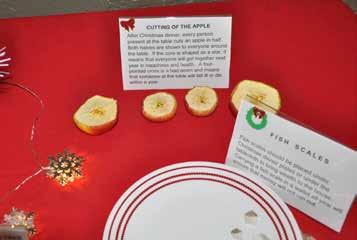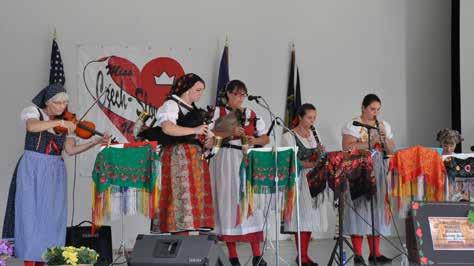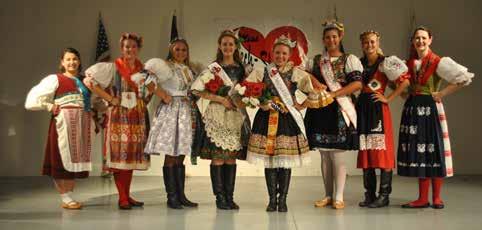
15 minute read
Christmas Around the World at Home
BY AMY HADACHEK
Comfort food baked in special ethnic traditions will bring food and family together this holiday season, and include newer family members who have similar and also diverse ethnic traditions. Heartwarming memories keep joy lit for people with heritages deeply steeped in Czech, German, Swedish and Mexican cultures.


CZECH
Czech history focuses on Christmas Eve, when the Czech traditional Christmas dinner is eaten. Fish soup (carp and fried carp) with potato salad is the traditional meal, particularly in “the old country.”
Pork and sauerkraut are a traditional Czech meal; sometimes with jaternice (pronounced Ith-er-Netsy; a Czech/Slovak sausage made from pork meat/offal and a filler of rice or barley, with garlic.) Kolaches (pronounced koh-lahtch; a round pastry with fruit in the middle) are always a treat.

Houska is a tasty braided Czech bread; baked with fruit, or nuts and a spice, and frosted.
“Regarding Christmas traditions, my husband and I visited the Czech Republic several years ago, in the town of Brno and we saw people fishing in horse tanks in the middle of street corners, with carps. Kids take the fish home to play with them in their bathtubs. Then, the fish are killed and eaten Christmas Eve,” said Doris Ourecky, president of the Wilbur, Nebraska Czech Museum. Wilbur, a quaint town with oldworld charm, was designated the Czech Capital of Nebraska in a Governor’s proclamation in 1963, and declared “The official ‘Czech Capital of the U.S.” by President Ronald Reagan in July 1987. Wilbur hosts a Christmas festival, and an annual Czech Days festival in early August with the National Miss Czech/Slovak U.S. Pageant, although both were cancelled this year due to COVID.
MIDDLE: The 2015-2016 Wilber Czech Royalty BOTTOM: Kroj display at the Wilber Czech Museum
Christmas AROUND THE WORLD at Home

Czech Christmas HoskaFrom allrecipes.com

Prep: 1 hr
Servings: 30
Cook: 45 mins Additional: 3 hrs 45 mins
Yield: 2 large loaves
Total: 5 hrs 30 mins
INGREDIENTS
1 (0.6 ounce) cake compressed fresh yeast ¼ cup warm water (110 degrees F/45 degrees C) ½½cup white sugar ½ ½cup butter 1 egg, beaten 1 teaspoon salt 2 cups scalded milk 6 cups all-purpose flour 1 pinch ground ginger 1 pinch ground mace ¼ teaspoon orange zest ½ cup golden raisins ½ cup candied mixed fruit peel ½ cup blanched slivered almonds 1 egg yolk 1 tablespoon milk 2 tablespoons confectioners’ sugar
DIRECTIONS
Dissolve yeast in warm water.
In a large bowl, cream sugar and butter. Add beaten egg and salt. Stir in cooled milk and then the yeast. Add 1 1/2 cups sifted flour; beat into a smooth batter. Cover and let rise until light, about one hour.
Stir spices and dried orange zest into the sponge. Add 4 1/2 cups of flour to make a soft dough. Place on a lightly floured board, and knead until smooth and elastic. Knead in raisins and candied peel. Put in a well oiled bowl, and turn once to coat the surface of the dough. Cover. Set aside to rise until double in bulk, about 2 hours.
Divide dough into ten parts, roll into desired lengths, and let rise about 15 minutes.
On a heavily greased baking sheet, make a braid of three parts, beginning in the center and working braid loosely toward each end. Pinch ends together. Twist the remaining two pieces together, and place on the base of the braid. In a small bowl, beat together egg yolk and milk; brush the loaf with this mixture. Sprinkle sliced almonds over the loaf. Repeat process for second loaf. Let rise about 45 minutes.
Bake at 350 degrees F for 45 minutes. Transfer bread to a wire rack, and cool completely. Cover while cooling with a tea towel to make a soft crust. Sprinkle with confectioners’ sugar.


TOP LEFT: 2015 All Contestants - The Miss Czech Slovak US

TOP RIGHT: Wilber Junior Czech Dancers
RIGHT: The Southeast Bohemian Bagpipe Band
COURTESY OF THE CZECH SLAVNOSTI NEWSPAPER

Christmas trees are decorated on Christmas Eve in the Czech Republic, Ourecky said. “When we were in the Czech Republic, we learned about the tradition of hiding a glass pickle in the Christmas tree, and the child who finds the pickle, gets to open gifts first.”
Karen Baxa of Cuba Kansas, a Czech community, learned to speak Czech when she was young. “My grandmother on my mom’s side came from Czechoslovakia and never spoke English. She lived in the next town; Munden, so as long as she was alive, we had to speak Czech.”
As for food, “We always have duck and sauerkraut, or goose for Thanksgiving. For Christmas Eve dinner, I made kolaches all the time.”
Czech family favorite meals include homemade bologna, and rohlíky – Czech Rolls with poppy seed served at many traditional Czech meals, also zelnicky – cabbage filled rolls.
As a three-time mayor of Cuba, Kansas, and the first president of the Cuba Booster Club, Joe Chizek organized Czech holiday festivals throughout the year at the local Czech-named Sokol Hall.
“My dad was full Czech. Mom made fruitcake and mince pie for all the holidays,” said Chizek, adding, “Czechs like duck.” His dad taught Chizek’s older sister to speak Czech and she spoke fluently. “But he just taught us a few words.”
So, at age 70, Chizek and (his late wife) Dee who was full-blooded German, were energized about learning the Czech language, and got dictionaries. Chizek wishes everyone a merry Christmas “vitame Navoce” (pronounced: Veeta-may Nahvochay, in the Czech language.)
SWEDISH
Cooking traditional Swedish dinners and pastries are a focal point for family and organized community festivals in Scandia, Kansas in north central Kansas.
“I make a lot of dishes that I learned from my mother and my mother in law. It’s too bad that a lot of younger kids don’t all carry on the traditions, although many families around here do,” said Jane Ann Carlgren, who runs the well-known Scandia Antique Mall in western Republic County. Carlgren’s parents are Swedish. Her husband’s parents are Norwegian.
“Two churches here used to do traditional Swedish dinners, which are very well attended,” said Carlgren. They featured Swedish potato bologna called potatis korv (fresh sausage with ground pork and beef; mixed with potatoes, onions, salt, pepper and allspice) and lutefisk, dried whitefish made from aged stockfish, traditionally part of the Christmas feast.
Ostkaka, known as Swedish cheesecake or curd cake, is a tasty Swedish dessert, Carlgren said. “The other thing we all really like around here is putting Lingonberries (sour/tart/slightly sweet) on top of the ostkaka. Other favorites are Swedish brown beans, Swedish rye bread, bond ost (farmer cheese) and the spritz cookies (almond extract, candied fruit, flour, eggs, milk.) All things we do for holidays,” said Carlgren. “Swedish meatballs with the brown sauce is very good, and the main ones in my family. Another tradition, which a lot of families here make all the time anyway, are Swedish pancakes, like a crepe, very thin which you roll and sprinkle powdered sugar.” Her Swedish friends enjoy making hardtacks, crackers that pioneers made. “On my husband’s side, date cakes, (with prunes and plums) are delicious. His grandmother and my mother-in-law made them, which was a tradition.”
Carlgren’s family is preparing to celebrate her mother in law’s 101st birthday in November. “She made all that food, and always made name-tags for them, so you would see the whole smorgasbord.”
The store of every Cowboy & Cowgirl’s Christmas dreams!
Shop online at www.CurveyRanchGirl.com 406-975-6226 Find us on Facebook!



Hot oiled & weighted tack for USING kinds of people! We carry sizes small - 4xl to accommodate all women!
Swedish Meatballs
Prep: 30 mins Cook: 35 mins
Yield: 6 servings Additional: 1 hr Total: 2 hrs 5 mins

INGREDIENTS
Meatballs
2 tablespoons butter ½ yellow onion, finely chopped 1½ teaspoons fine salt ¼ cup milk 2 large eggs ⅓ cup plain bread crumbs ¾ teaspoon freshly ground black pepper ¼ teaspoon ground nutmeg ¼ teaspoon ground allspice 1 pinch cayenne pepper, or to taste 1 pound ground beef chuck 1 pound ground pork
Gravy
2 tablespoons butter 3 tablespoons all-purpose flour 3¼ cups beef broth ½ cup heavy cream ½ teaspoon white sugar ¼ teaspoon Worcestershire sauce salt and freshly ground black pepper to taste cooking spray
DIRECTIONS
Melt 2 tablespoons butter in a large skillet over medium heat. Cook and stir onion and 1 1/2 teaspoons salt in butter until onion begins to turn translucent, about 6 minutes.
Transfer onion mixture to a large bowl. Add milk, eggs, bread crumbs, black pepper, nutmeg, allspice, and cayenne pepper to the breadcrumb mixture; stir to combine.
Mix beef and pork into the bread crumb mixture. Cover with plastic wrap and refrigerate for 1 hour. Melt 2 tablespoons butter in a large skillet over medium heat; whisk flour into butter and cook until golden brown, 4 to 5 minutes. Slowly whisk beef broth into butter mixture.
Increase heat to medium-high, whisk cream into mixture and bring to a simmer. Stir sugar and Worcestershire sauce into gravy. Simmer until slightly thickened, 6 to 7 minutes. Season with salt and black pepper. Remove from heat and set aside. Preheat oven to 425 degrees F (220 degrees C). Line a baking sheet with aluminum foil and lightly coat foil with cooking spray. Roll 2 to 3 tablespoons meatball mixture into a ball using wet hands; repeat with remaining meatball mixture. Place meatballs on the prepared baking sheet. Bake in the preheated oven until browned, about 20 minutes. An instant-read thermometer inserted into the center should read at least 160 degrees F (70 degrees C). Transfer meatballs to the gravy and cook over medium-low heat until warmed through, about 5 minutes. Country Christmas | The Fence Post 17
GERMAN
Germany has a prominent Christmas cookie tradition.
With heartfelt memories, each Christmas, Peter and Ziva Behrman of Georgetown, Texas near Austin, looked forward to special traditional holiday packages arriving when Peter’s mother Beulah (Booie) Behrman yearly sent them gifts of pffeffernusse (pronounced feffer-noose; a spicy round cookie with ground nuts, spices and covered with powdered sugar) and lebkuchen; which Booie baked. Lebkuchen is a traditional German spice cookie usually baked for Christmas. It’s similar to a soft gingerbread cookie, made with molasses, full of spices, with a glaze.
locatedat 711 O Street • Greeley, Colorado Financing & Delivery Available
All I Want for
Christmas...

Merry Christmas!
Full Service Trailer Repair Shop www.pinnacletrailersales.com • Sales-970-219-5699
“My mother made the lebkuchen – They’re very good; we always looked forward to receiving them at the holidays,” said Peter. “You can also buy them at places,” added Ziva, “and they are so delicious.”
The Dutch believe pfeffernusse (or pepernoten) are linked to the feast of Sinterklaas (similar to Santa Claus,) celebrated on Dec. 5 in the Netherlands and Dec. 6 in Germany and Belgium. Also called Saint Nicholas Day, or the Feast of Saint Nicholas, children sing songs about Sinterklaas and put shoes outside their bedroom doors or hang an empty stocking by the fireplace on the evening of Dec. 5. St Nicholas comes during the night, and the next morning children’s eyes widen upon seeing the shoes/ stockings filled with gifts and sugary treats.
Made-from-scratch German specialty breads are immensely popular at Wimberger’s Old World Bakery and Delicatessen in Colorado Springs, Colorado, which celebrated it 50th year in Colorado Springs in 2020.
“We bake stollen, which is more like a bread than a cake; it’s the original. We do carry pffeffernusse and lebkuchen but they are sent in from Germany,” said Ulrike Wimberger, owner. Christmas Stollen is a favorite German holiday treat; a jewel-like brandy-soaked fruit in an enriched dough.
With German Christmas traditions so close to the heart that she has intently shared them with her younger family, Wimberger reminisced about Christmases while growing up in Wertheim, German on the Main River (the longest tributary of the Rhine.) “We celebrate the gift giving on Christmas Eve. We don’t decorate the tree prior to that, and that was always a big secret,” she said. “My dad would get the tree, the bell would ring, and we came out to see the tree, sing songs and get our presents. We ate and went to Mass. I continue traditions for my own family here in Colorado.”
Pfeffernusse Cookies
Prep: 15 mins Cook: 15 mins
Yield: 3 dozen cookies Additional: 2 hrs 30 mins Total: 3 hrs

INGREDIENTS
½ cup molasses ¼ cup honey ¼ cup shortening ¼ cup margarine 2 eggs 4 cups all-purpose flour ¾ cup white sugar ½ cup brown sugar 1½ teaspoons ground cardamom 1 teaspoon ground nutmeg 1 teaspoon ground cloves 1 teaspoon ground ginger 2 teaspoons anise extract 2 teaspoons ground cinnamon 1½ teaspoons baking soda 1 teaspoon ground black pepper ½ teaspoon salt 1 cup confectioners’ sugar for dusting
DIRECTIONS
Stir together the molasses, honey, shortening, and margarine in a saucepan over medium heat; cook and stir until creamy. Remove from heat and allow to cool to room temperature. Stir in the eggs. Combine the flour, white sugar, brown sugar, cardamom, nutmeg, cloves, ginger, anise, cinnamon, baking soda, pepper, and salt in a large bowl. Add the molasses mixture and stir until thoroughly combines. Refrigerate at least 2 hours.
Preheat oven to 325 degrees F (165 degrees C). Roll the dough into acornsized balls. Arrange on baking sheets, spacing at least 1 inch apart. Bake in preheated oven 10 to 15 minutes. Move to a rack to cool. Dust cooled cookies with confectioners’ sugar.
MEXICAN
In Mexico, Christmas Eve is also a special time when Mexican families gather for homemade dinners of tamales and pozole (a traditional soup or stew from hominy with meat, shredded cabbage, onion, garlic, chile peppers, radishes, avocado, and salsa or limes).
“I remember when I was little, it was pozole and tamales, and ponche Navideño (Christmas punch) which has real fruit and you drink it hot,” said Jose Palomino, Manager of Los Primos Mexican Restaurant in Belleville, Kansas, who goes to Mexico most years to see his family.
“We all celebrate Christmas on Christmas Eve,” said Palomino.
A favorite gift-giving tradition in Mexico is the intercambios, meaning exchange (of gifts.)
“People do a lot of putting names in a cup, you pick one name, and give a gift to that person. It’s a surprise when you open your gift,” he said. Palomino’s family, and many others, enjoy piñatas. “Then Christmas Day, Dec. 25, it’s normal; it’s quiet,” Palomino said.

That’s because, for a solid 30-days prior, festivals are held every day to celebrate the spirit of the holidays from November leading up to Christmas Eve.
“In Mexico, it all starts Nov. 27 for 12 days and ends Dec. 12. People go see the (image of Mary) Virgin of Guadalupe Dec. 12.” Festivals with children in costumes celebrate ta man encountering the Virgin Mary, Mexico’s patron saint, in Mexico City Dec. 9 and 12, 1531.
Nochebuena, Christmas Eve, features a festival commemorating the birth of Jesus.
“When I’m there, festivals are held every single day through Dec. 31,” said Palomino. “That’s a lot of festivals.”
INGREDIENTS
1 1⁄2 lbs pork shoulder 2 garlic cloves, peeled 1 tablespoon cumin powder 1 onion, chopped 2 garlic cloves, chopped 2 tablespoons oil 1⁄2 teaspoon black pepper
Pozole
1⁄2 teaspoon cayenne 2 tablespoons California chili powder 1 tablespoon salt 1⁄4 teaspoon oregano 4 cups canned white hominy, drained and rinsed 3 –5 cups pork broth, from cooking pork shoulder 1 cup canned diced green chiles (optional) salt
2 whole fresh jalapenos, chopped (optional) 3 whole ancho chiles, seeded and stemmed (garnish, optional)
DIRECTIONS

Rinse and drain the hominy. Place the meat in a large saucepan and just cover with lightly salted water. Add 1/2 chopped onion, the 2 cloves peeled garlic, pepper, cumin, and oregano. Bring to a boil over medium heat, skim off any foam that rises, reduce heat, cover and simmer for 45 minutes.
Remove meat and broth, reserving both. Sauté the remaining chopped onion and garlic in oil until translucent. Add the remaining spices, stir for a minute. Cut the reserved pork into 1-inch cubes and add to the pan. Stir in the canned hominy, pork broth (if there is not enough pork broth, add chicken stock, about 2-4 cups, eyeball the amount you like), green chiles and jalapenos (optional). Cook at a simmer, covered, for 45 to 60 minutes until the meat and hominy are tender. If necessary, cook for up to an additional 60 minutes until the chiles and onions are well blended into the broth.
Degrease the stew, taste for salt, and serve in soup bowls. Garnish with lime/lemon wedges, sliced radishes, chopped cilantro, shredded green cabbage, fresh/ packaged fried corn tortillas. Boil the ancho chilies in a separate small pot for the garnish. When ancho chilies are soft from boiling (takes about 15 minutes), put them in the blender with 1 ½ cups of water, 1 clove of garlic, 2 tablespoons diced onion and about 1 tablespoon of salt and pepper. Blend this thin, then strain it to get the liquid separated from the pulp. Add the pulp to the soup for flavor, but discard if it’s too spicy. Put the remaining Country Christmas | The Fence Postliquid in a serving dish for guests to add to their soup, if they like it HOT. 21






